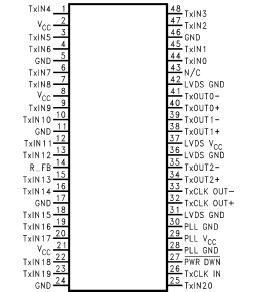DS90C363: Features: · 20 to 65 MHz shift clock support· Programmable Transmitter (DS90C363) strobe select (Rising or Falling edge strobe)· Single 3.3V supply· Chipset (Tx + Rx) power consumption < 250 mW (...
floor Price/Ceiling Price
- Part Number:
- DS90C363
- Supply Ability:
- 5000
Price Break
- Qty
- 1~5000
- Unit Price
- Negotiable
- Processing time
- 15 Days
SeekIC Buyer Protection PLUS - newly updated for 2013!
- Escrow Protection.
- Guaranteed refunds.
- Secure payments.
- Learn more >>
Month Sales
268 Transactions
Payment Methods
All payment methods are secure and covered by SeekIC Buyer Protection PLUS.

 DS90C363 Data Sheet
DS90C363 Data Sheet







